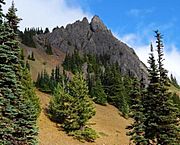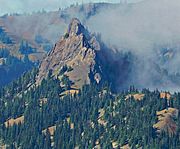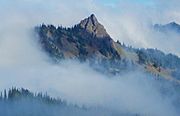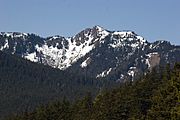Steeple Rock (Washington) facts for kids
Quick facts for kids Steeple Rock |
|
|---|---|
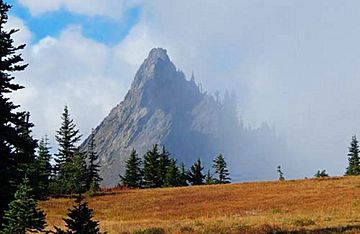
Steeple Rock seen from the east
|
|
| Highest point | |
| Elevation | 5,567 ft (1,697 m) |
| Prominence | 567 ft (173 m) |
| Geography | |
| Location | Clallam County, Washington, United States |
| Parent range | Olympic Mountains |
| Topo map | USGS Mount Angeles |
| Geology | |
| Age of rock | Eocene |
| Type of rock | Basalt |
| Climbing | |
| Easiest route | Scrambling class 3 |
Steeple Rock is a cool rock pillar in the Olympic Mountains of Washington state. It's about 200 feet (61 m) tall and made of a rock called basalt. You can find it in Clallam County, right next to the Obstruction Point Road. This road is on Hurricane Ridge inside Olympic National Park.
Steeple Rock sits between Eagle Point and the Hurricane Ridge Visitor Center. Rain and melting snow from the rock flow into small streams. These streams eventually join the Elwha River and Morse Creek, which then empty into the Strait of Juan de Fuca.
Contents
Understanding the Climate Around Steeple Rock
Steeple Rock is in the northern part of the Olympic Mountains. This area has a "marine west coast" climate. This means the weather is greatly affected by the nearby Pacific Ocean.
How Weather Forms Here
Most weather systems start over the Pacific Ocean. They then move northeast towards the Olympic Mountains. When these weather systems hit the tall mountains, they are forced to rise. As the air goes higher, it cools down. This causes the moisture in the air to turn into rain or snow. This process is called Orographic lift.
Rain, Snow, and Sunshine
Because of this, the Olympic Mountains get a lot of rain and snow. Winter months often bring heavy snowfall. The weather is usually cloudy during winter. However, in summer, large areas of high pressure form over the Pacific Ocean. This often brings clear skies and lots of sunshine.
Wet Snow and Avalanches
Since the ocean influences the climate, the snow here tends to be wet and heavy. This kind of snow can lead to a high risk of avalanches. An avalanche is when a large amount of snow slides quickly down a mountain.
Exploring the Geology of the Olympic Mountains
The Olympic Mountains are very different from other mountain ranges like the Cascades. They are not volcanic, meaning they were not formed by volcanoes. They also don't have granite rock.
How the Mountains Were Built
The Olympic Mountains are mostly made of old ocean floor material. This includes sandstones and basaltic rocks. These rocks were pushed up from under the sea millions of years ago.
From Ocean Floor to Mountains
About 35 million years ago, there was a tectonic plate called the Farallon Plate. This plate was part of the Pacific Ocean floor. It slowly moved eastward towards North America. Most of this ocean floor slid under the North American land mass. This process is called subduction.
However, some parts of the ocean floor didn't slide under. Instead, they were scraped off and pushed against the mainland. This created a large dome shape that was the beginning of the Olympic Mountains we see today.
Mountains Rising from the Sea
Over time, powerful forces continued to push the rocks upwards. This caused the layers of rock to stand on their sides. Different types of rock also got mixed together. All of this happened underwater. The Olympic Mountains only started to rise above the sea about 10 to 20 million years ago.
Gallery




